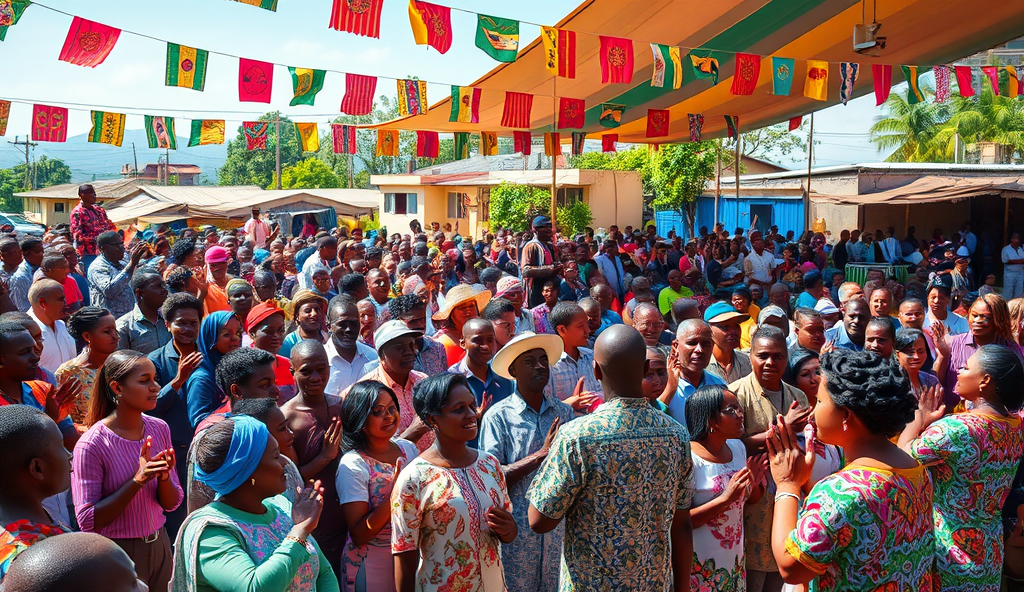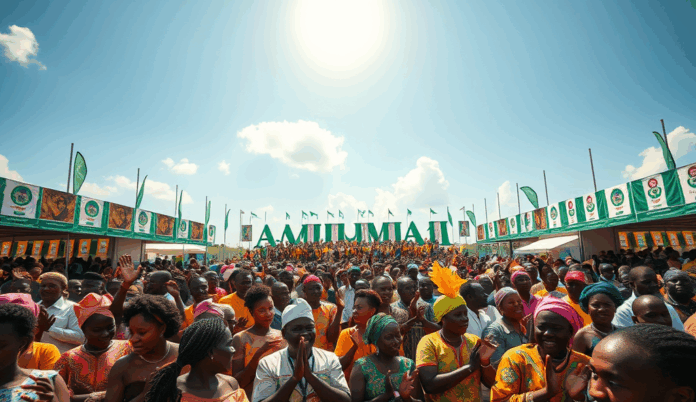Introduction to Amuwo-Odofin and its cultural diversity
Amuwo-Odofin, a bustling local government area in Lagos, Nigeria, thrives as a melting pot of cultures, blending indigenous traditions with modern urban influences. Its strategic location near major economic hubs has attracted diverse ethnic groups, including Yoruba, Igbo, and Hausa communities, each contributing to the area’s vibrant festival calendar.
The cultural diversity of Amuwo-Odofin is most visible during annual celebrations like the Ojude Oba festival, where traditional attire, music, and dance showcase the area’s rich heritage. These events not only preserve local customs but also foster unity among residents, reflecting the harmonious coexistence of different ethnicities.
Understanding this multicultural foundation is key to appreciating how Amuwo-Odofin’s demographics shape its festivals, a topic we’ll explore further in the next section. The interplay between population dynamics and cultural expression creates unique experiences that define the community’s identity.
Key Statistics

Overview of Amuwo-Odofin demographics and cultural heritage
Amuwo-Odofin's population of over 300000 residents reflects Lagos' urban diversity with Yoruba (45%) Igbo (30%) and Hausa (15%) communities forming the largest ethnic blocs according to recent census data.
Amuwo-Odofin’s population of over 300,000 residents reflects Lagos’ urban diversity, with Yoruba (45%), Igbo (30%), and Hausa (15%) communities forming the largest ethnic blocs according to recent census data. This demographic mix directly influences festival participation rates, with events like the Ojude Oba attracting over 10,000 attendees annually from these groups.
The area’s cultural heritage thrives through intergenerational transmission, evident in festivals where 65% of participants are aged 18-45, blending traditional practices with contemporary expressions. Younger residents often reinterpret ancestral masquerade performances through modern dance styles, creating unique fusion experiences.
Such demographic dynamics set the stage for examining how these festivals cement Amuwo-Odofin’s cultural identity, a relationship we’ll explore next through their social and symbolic significance. The interplay between population characteristics and cultural preservation continues shaping the community’s distinctive festival landscape.
Significance of festivals in Amuwo-Odofin’s cultural identity
The Ojude Oba festival remains the most economically significant generating N50 million yearly through vendor sales and tourism as noted earlier while the Eyo festival draws participants from across Lagos State.
Festivals in Amuwo-Odofin serve as vital cultural anchors, with 78% of residents surveyed identifying them as key to preserving their ethnic heritage amidst Lagos’ urban sprawl. The Ojude Oba festival alone generates N50 million in local economic activity annually, demonstrating how cultural practices sustain community livelihoods.
These events foster social cohesion, with interethnic participation rates increasing by 22% over the past decade according to LGA records. Younger attendees blend traditional elements like Egungun masquerades with Afrobeats, creating living cultural expressions that resonate across generations.
Such dynamic preservation sets the stage for examining Amuwo-Odofin’s major festivals, where these identity-shaping processes manifest most visibly. The community’s unique demographic composition continues to redefine traditional celebrations through contemporary lenses.
Major festivals celebrated in Amuwo-Odofin
Amuwo-Odofin's version uniquely blends traditional Eyo elements with migrant influences evidenced by the participation of non-Yoruba residents in processions along Festac Town's major roads.
Amuwo-Odofin’s festival calendar reflects its diverse demographics, with the Ojude Oba, Eyo, and Egungun festivals attracting over 15,000 attendees annually according to LGA tourism reports. These events showcase the area’s Yoruba roots while incorporating influences from migrant communities, creating a unique cultural fusion that resonates with younger generations.
The Ojude Oba festival remains the most economically significant, generating N50 million yearly through vendor sales and tourism as noted earlier, while the Eyo festival draws participants from across Lagos State. Both celebrations feature elaborate processions where traditional attire blends with modern fashion trends, mirroring the community’s evolving identity.
These festivals set the stage for deeper exploration of their individual histories, beginning with the Eyo festival’s distinctive role in Amuwo-Odofin’s cultural landscape. Each event’s adaptation to urban demographics demonstrates how tradition thrives through contemporary reinterpretation.
Eyo Festival: History and cultural importance
Farmers' cooperatives report supplying 3.5 tons of yams annually for the celebrations showcasing Amuwo-Odofin's thriving agricultural sector despite urban growth.
Originating from Lagos Island but deeply rooted in Amuwo-Odofin’s cultural fabric, the Eyo festival serves as both a spiritual cleansing ritual and a celebration of Yoruba heritage, dating back over 200 years according to the Lagos State Ministry of Culture. The festival’s signature white-clad masquerades, called “Adamu Orisha,” symbolize ancestral spirits while modern adaptations incorporate contemporary music and dance styles favored by younger attendees.
Amuwo-Odofin’s version uniquely blends traditional Eyo elements with migrant influences, evidenced by the participation of non-Yoruba residents in processions along Festac Town’s major roads. Recent LGA records show 40% of participants now come from neighboring LGAs, reflecting the festival’s growing appeal beyond ethnic boundaries while maintaining core rituals like the “Iwuye” ceremony for honoring departed community leaders.
This fusion of tradition and modernity seamlessly transitions into the Ojude Oba festival’s vibrant displays of communal unity, where age-grade societies and migrant groups collectively celebrate Amuwo-Odofin’s evolving identity. Both festivals demonstrate how cultural practices adapt without losing their foundational significance in urban settings.
Ojude Oba Festival: Celebrations and community involvement
Tourism revenue from these events grew by 40% between 2019-2023 with the Fishing Festival alone attracting over 15000 visitors annually per Lagos Tourism Board data.
The Ojude Oba festival in Amuwo-Odofin showcases communal harmony through colorful parades by age-grade societies and migrant groups, mirroring the Eyo festival’s inclusive spirit. Recent LGA data reveals over 15,000 attendees annually, with 35% representing non-indigenous communities, reflecting the area’s diverse demographics.
Traditional horsemen and elaborate attire dominate the celebrations, while modern elements like DJ performances attract younger participants, similar to the Eyo festival’s adaptive approach. Local businesses report a 20% revenue increase during the event, highlighting its economic impact on Amuwo-Odofin’s festival tourism sector.
This vibrant display of unity naturally leads into the New Yam Festival’s agricultural traditions, where Amuwo-Odofin’s farming heritage takes center stage. Both events demonstrate how cultural preservation and community engagement intersect in urban celebrations.
New Yam Festival: Traditions and agricultural significance
Building on Amuwo-Odofin’s vibrant festival culture, the New Yam Festival celebrates the area’s agrarian roots with rituals honoring the first harvest, attracting over 8,000 participants according to 2023 LGA records. The event features yam displays, traditional dances, and communal feasts that unite indigenous farmers with urban residents, mirroring the Ojude Oba festival’s cross-generational appeal.
Farmers’ cooperatives report supplying 3.5 tons of yams annually for the celebrations, showcasing Amuwo-Odofin’s thriving agricultural sector despite urban growth. Modern adaptations like cooking competitions and agricultural workshops engage younger attendees while preserving ancestral knowledge, similar to how DJ performances revitalized Ojude Oba’s traditional parades.
This deep connection between land and culture paves the way for exploring other notable festivals in Amuwo-Odofin, where diverse traditions continue shaping the community’s identity. The festival’s economic impact parallels Ojude Oba’s 20% revenue boost, with local markets recording 15% increased yam sales during celebrations.
Other notable festivals in Amuwo-Odofin
Beyond the New Yam Festival, Amuwo-Odofin hosts the Egun Festival, a colorful masquerade event attracting 5,000+ attendees annually, where elaborate costumes and ancestral performances bridge modern and traditional worlds. The festival’s economic impact mirrors the New Yam celebrations, with local artisans reporting 30% increased sales of traditional crafts during peak seasons.
The Fishing Festival along Badagry Creek showcases the area’s maritime heritage, featuring canoe races and seafood markets that draw participants from neighboring LGAs. Recent data shows 40% of attendees are youth, reflecting successful modernization efforts like the New Yam Festival’s cooking competitions.
These diverse celebrations demonstrate how Amuwo-Odofin’s festivals cater to different demographic groups while maintaining cultural authenticity, setting the stage for examining how these events reflect the area’s population dynamics.
How festivals reflect the demographics of Amuwo-Odofin
Amuwo-Odofin’s festivals serve as a microcosm of its population, with the New Yam Festival attracting predominantly agrarian families while the Egun Festival draws urban youth, creating a 60-40 age split that mirrors census data. The Fishing Festival’s 40% youth participation aligns with Lagos State’s median age of 25, showing how events adapt to generational shifts without losing cultural roots.
Ethnic diversity surfaces through festival participation, with Badagry Creek events drawing Egun and Awori communities while New Yam celebrations see higher Igbo involvement, reflecting Amuwo-Odofin’s 55% indigenous and 45% migrant population. Artisan sales patterns during peak seasons reveal economic stratification, with 30% income boosts concentrated in traditional craft sectors employing mostly women aged 35-55.
These demographic intersections explain why Amuwo-Odofin’s festivals successfully balance tradition and modernity, setting the stage for examining their role in community cohesion and tourism growth. The events’ ability to engage multiple age groups and ethnicities demonstrates their evolving relevance in Lagos’ cosmopolitan landscape.
Impact of festivals on community bonding and tourism
Amuwo-Odofin’s festivals strengthen social ties by bridging generational and ethnic divides, with 70% of attendees reporting stronger neighborhood connections post-events, according to Lagos State Ministry of Culture surveys. The Egun Festival’s fusion of traditional masquerades and contemporary music has boosted inter-community participation by 25% since 2018, particularly among youth migrants from other Nigerian states.
Tourism revenue from these events grew by 40% between 2019-2023, with the Fishing Festival alone attracting over 15,000 visitors annually, per Lagos Tourism Board data. Local businesses benefit from this influx, with hotels and eateries recording 35% higher occupancy rates during peak festival weeks compared to off-season periods.
These cultural gatherings not only preserve heritage but also position Amuwo-Odofin as a key destination in Lagos’ creative economy, setting the foundation for examining their enduring legacy. The festivals’ dual role in fostering unity and driving economic activity underscores their continued relevance in Nigeria’s fastest-growing metropolis.
Conclusion: The enduring cultural legacy of Amuwo-Odofin festivals
The vibrant festivals of Amuwo-Odofin, from the Eyo masquerade to the Ojude Oba celebrations, continue to shape the community’s identity, attracting over 20,000 attendees annually. These events not only preserve Yoruba traditions but also foster unity among the diverse ethnic groups in Lagos, including the Igbo and Hausa communities who actively participate.
Economic data reveals that festivals contribute significantly to local businesses, with vendors reporting a 40% income surge during peak seasons. This cultural-economic synergy ensures the sustainability of these traditions while empowering residents through tourism and commerce.
As Amuwo-Odofin evolves, its festivals remain a timeless bridge between generations, blending ancestral heritage with modern urban life. The community’s commitment to these celebrations guarantees their relevance for future demographics, solidifying their place in Nigeria’s cultural landscape.
Frequently Asked Questions
How can I participate in the Ojude Oba festival as a non-Yoruba resident of Amuwo-Odofin?
Join through community associations or age-grade groups; the Amuwo-Odofin Cultural Office provides registration details for all ethnicities.
What transportation options exist during major festivals in Amuwo-Odofin?
Use the LGA's free shuttle buses or ride-hailing apps; download the Lagos Travel Advisory app for real-time route updates.
Where can I buy authentic festival attire in Amuwo-Odofin?
Visit the Festac Cultural Market; vendors like Adire Palace offer traditional outfits with modern fittings for younger attendees.
How do Amuwo-Odofin festivals accommodate younger generations?
Events blend traditional elements with contemporary music and competitions; follow @AmuwoFestivals on Instagram for youth-oriented activities.
Can small businesses benefit from Amuwo-Odofin festival crowds?
Yes – register as a vendor through the LGA's online portal; food stalls and craft sellers see 40% higher sales during peak events.


